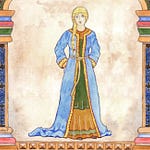Ælfgif-who? provides short biographies of early medieval English women. Click on the podcast player if you’d like to hear this newsletter read aloud in my appealing Yorkshire accent.

Data Destruction: What was lost in the Cotton library fire
There has been a lot of anxiety recently over on Twitter (or… X?) about the potential collapse of the platform, with many questioning whether the slow death of the website would mean that old data - expert commentary, the accounts of departed loved ones, responses to big moments in history - will be gone forever.
This discussion has got me thinking about moments of data destruction in history - catastrophic and irrevocable losses of historical documents and artefacts. There have been countless incidents in which libraries have been destroyed - from the infamous Library of Alexandria, to the shelling of the Strasbourg library and archaeological collections in 1870, to the burning and looting of the Iraq National Archive in 2003 during the US occupation, to the recent 2021 Table Mountain fire which gutted the University of Cape Town’s Special Collections library.
There is even a Wikipedia page devoted to the destruction of libraries, but my warning is to tread carefully, as even contemplating such historical losses, both accidental and deliberate, is every historian’s nightmare.
One such event is notorious among medievalists: the 1731 fire at the unfortunately named Ashburnham House, home to hundreds of invaluable medieval manuscripts once owned by the collector Sir Robert Cotton, as well as hundreds of manuscripts belonging to the Old Royal Library collections. This library contained some of the most iconic medieval books, including Beowulf, the Lindisfarne Gospels, and the Magna Carta.
In the small hours of the 23rd October, 1731, a wooden mantle above a stove caught fire in the room directly below the Cotton and Royal collections. The flames quickly crept up the wooden panelling and timber beams into the room above, creating a huge smoke that alerted the keeper of the collections, Dr Bentley, to the fire.












